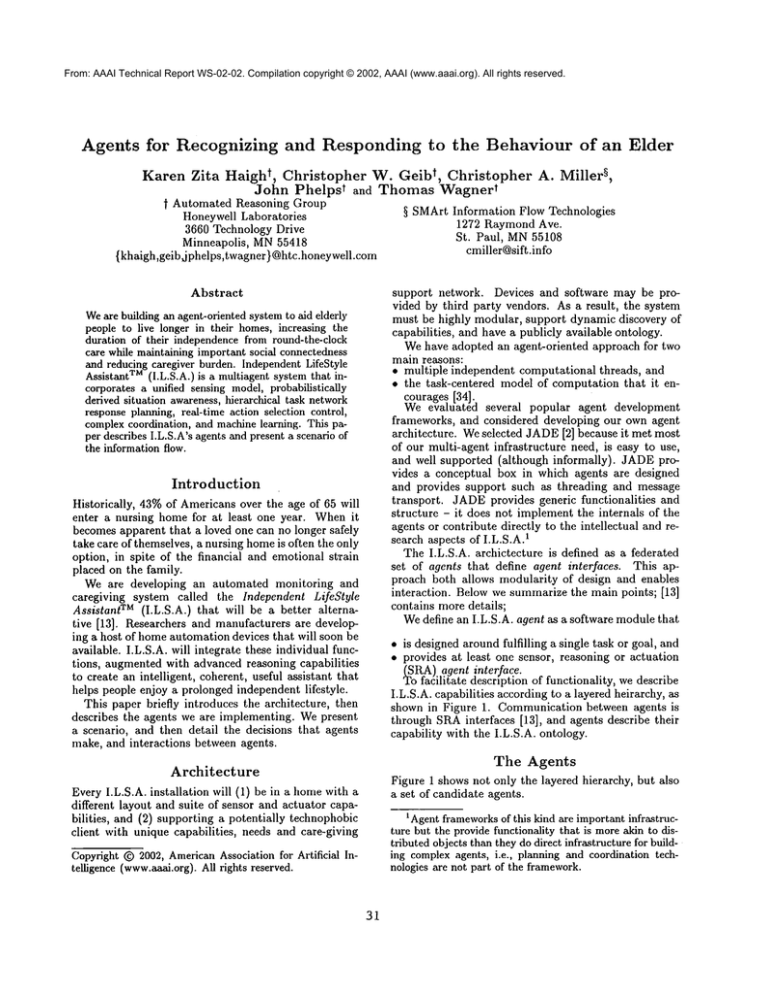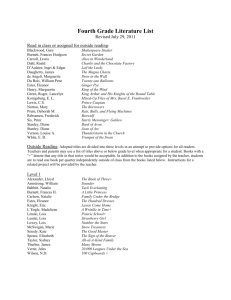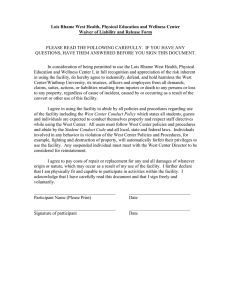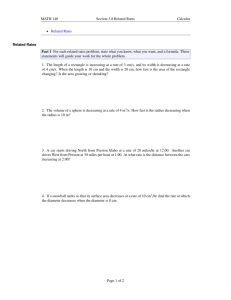
From: AAAI Technical Report WS-02-02. Compilation copyright © 2002, AAAI (www.aaai.org). All rights reserved.
Agents
for
Recognizing
and Responding
Karen Zita Haight, Christopher
to the
Behaviour
W. Geib t, §,
Christopher
of an Elder
A. Miller
John
Phelpst
and Thomas
Wagnert
f Automated Reasoning Group
§ SMArt Information Flow Technologies
Honeywell Laboratories
1272 Raymond Ave.
3660 Technology Drive
St. Paul, MN55108
Minneapolis,
MN55418
cmiller@sift.info
{ khaigh,geib j phelps,twagner} @htc.honeywell.com
Abstract
support network. Devices and software may be provided by third party vendors. As a result, the system
must be highly modular, support dynamic discovery of
capabilities,
and have a publicly available ontology.
We have adopted an agent-oriented
approach for two
main reasons:
¯ multiple independent computational threads, and
¯ the task-centered
model of computation that it encourages [34].
We evaluated
several
popular agent development
frameworks, and considered developing our own agent
architecture.
We selected JADE[2] because it met most
of our multi-agent infrastructure
need, is easy to use,
and well supported (although informally).
JADE provides a conceptual box in which agents are designed
and provides support such as threading and message
transport.
JADEprovides generic functionalities
and
structure - it does not implement the internals of the
agents or contribute directly to the intellectual and re1search aspects of I.L.S.A.
The I.L.S.A. archictecture
is defined as a federated
set of agents that define agent interfaces.
This approach both allows modularity of design and enables
interaction.
Below we summarize the main points; [13]
contains more details;
We define an I.L.S.A. agent as a software module that
Weare building an agent-oriented system to aid elderly
people to live longer in their homes, increasing the
duration of their independence from round-the-clock
care while maintaining important social connectedness
and reducing caregiver burden. Independent LifeStyle
Assistant TM (I.L.S.A.) is a multiagent system that incorporates a unified sensing model, probabilistically
derived situation awareness, hierarchical task network
response planning, real-time action selection control,
complex coordination, and machine learning. This paper describes I.L.S.A’s agents and present a scenario of
the information flow.
Introduction
Historically,
43% of Americans over the age of 65 will
enter a nursing home for at least one year. When it
becomes apparent that a loved one can no longer safely
take care of themselves, a nursing homeis often the only
option, in spite of the financial and emotional stwain
placed on the family.
We are developing
an automated monitoring
and
caregiving system called the Independent LifeStyle
Assistant TM (I.L.S.A.) that will be a better alternative [13]. Researchers and manufacturers are developing a host of home automation devices that will soon be
available. I.L.S.A. will integrate these individual functions, augmented with advanced reasoning capabilities
to create an intelligent, coherent, useful assistant that
helps people enjoy a prolonged independent lifestyle.
This paper briefly introduces the architecture,
then
describes the agents we are implementing. We present
a scenario, and then detail the decisions that agents
make, and interactions
between agents.
¯ is designed around fulfilling a single task or goal, and
¯ provides at least one sensor, reasoning or actuation
lL~) agent interface.
facilitate description of functionality, we describe
I.L.S.A. capabilities according to a layered heirarchy, as
shown in Figure 1. Communication between agents is
through SRAinterfaces [13], and agents describe their
capability with the I.L.S.A. ontology.
~o
The
Architecture
Figure 1 shows not only the layered hierarchy,
a set of candidate agents.
Every I.L.S.A. installation will (1) be in a home with
different layout and suite of sensor and actuator capabilities,
and (2) supporting a potentially technophobic
client with unique capabilities,
needs and care-giving
Copyright q~) 2002, AmericanAssociation for Artificial
telligence (www.aaai.org). All rights reserved.
Agents
but also
IAgent frameworksof this kind are important infrastructure but the provide functionality that is more akin to distributed objects than they do direct infrastructure for building complex agents, i.e., p]annlng and coordination technologies are not part of the framework.
In-
31
Log Manager
The database managercontrols access to the database.
It provides data only to authorized agents, and provides
only the data that is requested.
Configuration
& Customization
This agent allows the installer to input configuration
information about the client, the care givers, other actors in the domain, and also all relevant information
about the house. Information about people includes capabilities, telephone numbers,schedules, and what kind
of messages to send to whom. Information about the
house includes house plan, device layout, and mainenance schedules.
Ontology
The ontology is commonvocabulary that lets agents
(human or computer) communicate with precision
about some aspect of the world (domain). It structures
the domainknowledgein ways that allow it to be analyzed, making assumptions more explicit. The ontology
agent parses the heirarchical structure of the ontology
to understand relationships between items.
Sensor
Adapter
The sensor adapter reads the log of sensor firings, compensates for any latencies in data transmission, and
then forwards the data into the agent architecture.
32
Event Recognition
The event recognition agent combines multiple sensor
reports into a single event. For example, the following
four sensor reports all indicate that the person has entered a room: pressure-pad outside the door, followed
by door-beam,followed by pressure-pad inside the door,
followed by motion in the room. Note that this functionality effectively filters sensor data.
Clients
& Home Agents
The client (home) agent montors and manages information about the client (home). This information would
include both current and past information, such as location, activity, and capabilities, as well as preferred
interaction mechanisms. The information may be configured (by the client or a care giver), inferred (situation
assessment or intent recognition) or learned (machine
learning).
Note that if we expect multiple actors in the home
(e.g. a spouse), then there will be a similar agent for
each actor.
Intent
Recognition
Intent Recognitionis the process of inferring the goals
of an actor on the basis of observation of the actor’s
actions. Intent Recognition is only valid for actions
taken by the actor. Weare using the probabilistic task
tracker developedby Geib et al [8].
The stream of observations for IR is the set of recognized events. The IR agent combines multiple events
to infer the goals of the actor.
This task tracker considers all hypotheses, and actively reweights them as new evidence is added. It can
recognize that one event sequence may mean two different things (competing possibilities), and is aware
how confident it is in the recognized sequence. It is
resilient to missedobservations.
The library of plans that describe the behaviour of
an actor are provided by the DomainAgents.
Domain Agents
Each installation of I.L.S.A. will likely have multiple
domainagents. Each domainagent is a ’specialist’ in
a functional area of interest to the elder or their care~
givers. Exampledomainagents include fire safety, home
security, medication management,mobility, sleeping,
toileting, and security. Whenthe client installs a particular domainagent, new sensing or actuation devices
may need to be installed as well. These new devices
maybe unique to a particular domainagent, or may be
utilized by all the domainagents in the system.
A domainagent is responsible for all the reasoning
directly related to its functional area. It does situation
assessment, provides intent recognition libraries, and
creates initial response plans:
¯ Situation Assessment answers the question "Whatis
the state of the world." Assessment can be done on
the basis of a single event, whether or not the event
was performed by the actor. Information will include
the state of devices, and may include the state of
actors. For example, an agent may need to know
whether the TVis on or off, its volume, and current
channel.
¯ The domainagent also needs to provide plan libraries
for the intent recognition agent. A plan will describe
the set of observed actions that contribute to recognizing a behaviour of interest. For example, "taking medication" requires going into the room, approaching the medication cabinet, opening the cabinet, taking the pills, closing the cabinet, and leaving
the room. "Grooming" requires entering the room,
and one or more of (a) taking a shower, (b) running
water the sink, and (c) using the toilet, then finally
leaving the room.
¯ Finally, the domainagent needs to propose an appropriate response to the situation. It needs to decide
whether to wait for more evidence, explicitly gather
more evidence, or interact. It needs to decide what
devices to use and which people to contact. The domain agent proposes an interaction based only on its
specialized knowledge, in other words it proposes a
"context-free" response.
Interaction
Design System (IDS)
IDS decides, based on the task, howto present the data.
IDS designs an interaction that meets the requirements
as best as possible. Requirements include the capabilities of the person, howurgent the messageis, and
what type of data is being presented. IDS dynamically
responds to the current situation, and allows a more
flexible accomodationof interaction devices.
Response Coordinator
The Response Coordinator coordinates the responses
of the domain agents. It will merge and suppress all
interactions as appropriate, based on context. For example, if the client has fallen (alarm state), the RCwill
suppress a reminder to take medication. Multiple reminders to the client will be mergedinto one message.
Mergedmessages will be sorted in priority order,
where priority is defined by the domainagent (e.g. fall
monitoring is more important than eating), as well as
by the type of message(i.e. alarms are more important
than alerts). Merged messages can be used by a recipient to infer activity about the domain;for example
"ALARM
fire. ALARM
fall. ALERTno mobility. NOTIFICATIONunexpected midnight motion on stairs"
could be used by a care giver to infer that the client
tried to escape from the fire, but fell on the stairs and
hasn’t movedsince.
In our implementation, the response coordinator centralizes agent coordination. Wechose this approach
because all of the involved agents interact with a small
subset of humans through a small subset of devices.
In other words, all activities involving communications
with the outside world are strongly interrelated.
Device Agents
Device agents manageindividual actuators. Each agent
is a specialist for a particular device; examplesinclude
a telephone agent, a television agent, and a lighting
control agent.
Machine Learning
Machinelearning capabilities allow the system to improve its behaviour over time [12]. They will enable
I.L.S.A. to automatically configure itself, and to adapt
to changing conditions. MLwill learn models of the
environment and of the actors in the environment. The
learned information can be used by any of the other
agents in the system. For example, the domain agents
maylearn what the most effective response is for a given
situation. The intent recognition agent maylearn the
structure of behaviours for a particular elder [11]. The
interaction design system maylearn the most effective
way to present information.
Scenario
To better understand the capabilities of each of the
agents and I.L.S.A. functionality, Table 1 presents a
scenario in whichour client, Lois, forgets the teakettle
on the stove. Wefollow with a detailed system-level
description of what I.L.S.A. does for each step of the
scenario.
According to the architecture described earlier, we
require 14 agents to support this scenario, and approximately 10 sensors and actuators (with somedevices act-
Onenight Lois is on her wayto turn off the teakettle whenshe’s distracted by the phone’s double ring and flashing
red light which tells her that Margeis calling. The TV, which was loudly broadcasting Jeopardy, automatically mutes
itself so that Lois can better hear the conversation. After Lois hangs up, she forgets all about her tea and goes back
to watch Jeopardy. Later, the water in the teakettle has boiled away, and I.L.S.A. senses particulate buildup through
the kitchen’s air quality sensor. I.L.S.A. readjusts the household fans to clear out the smoke.
Since Lois still has the same stove she bought in 1952, I.L.S.A. itseff is unable to turn off the burner, so it must
communicatewith Lois directly. First it must find her, though, because the insurance companydidn’t cover the full
motion sensor suite. Because Lois recently used the remote control in the living room, and the television is still on,
I.L.S.A. suspects she might still be there. It presents a messageon the TVscreen: "Lois, turn off the stove," along
with an image of a stove and smoking pan. A spoken message would have been required ff Lois had been blind, or
if I.L.S.A. had thought she was asleep, but neither is true. Given that Lois has responded more frequently to ~isual
text and image combinations in the past, I.L.S.A. chooses this interaction method.
Unfortunately, Lois is no longer watching TV. She has gone to the bedroomfor her knitting during a commercial.
Becauseshe hasn’t responded to the alert, and this is an emergency,I.L.S.A. flicks selected lights on and off several
times throughout the house to get her attention. In her bedroom, Lois checks the bedside I.L.S.A. display and hurries
to the kitchen to turn off the stove. She arrives just in time, too - any longer, and I.L.S.A. would have called the
next-door neighbor or other help if necessary.
Table 1: AnI.L.S.A. scenario: "The Teakettle"
call. It asks ResponseCoordinator to enunciate the
phone call. Response Coordinator requests Lois’ capabilities from Client Expert. Client Expert has previously asked DB Mgr for all information relevant
for Lois. Client Expert reports a hearing difficulty,
so ResponseCoordinator decides that visual cues are
needed, with additional lights.
Response Coordinator, seeing no other requests for
interactions
and no current alarm state that might
suppress the phone call, tells PhoneCtrl to let the
phone ring and flash the lights.
TV mutes. Response Coordinator recognizes the interaction between the phone and other devices - Lois
may not hear the phone ring or the conversation if
the house is too noisy. As a result, Response Coordinator decides to reduce other sounds. It tells TVto
mute the television.
TVuses the IR. control signals
(like the remote control) to mute the television.
I.L.S.A.
senses particulates
and starts
responding.
The air quality sensor raises an alarm. The domain
agent Fire asks Intent Recognition whether Lois is
likely to turn off the stove. Intent Recognition knows
that she has not been in the kitchen for a while (her
departure was reported by Client Expert), and reports
that she is not likely to turn off the stove. As a result,
Fire realizes that it needs to respond. As there is no
device agent StoveCtrl, Fire realizes that it can’t turn
off the stove, and needs to use a different mechanism
to respond.
I.L.S.A.
adjusts
the Household Fans. The HVAC
system is a good choice to reduce the smoke level, so
Fire asks ResponseCoordinator to turn on the fans in
the kitchen. Response Coordinator passes this message
to HVAC.
I.L.S.A.
tries
to contact Lois. At this current
(low) level of urgency, it is appropriate to contact
Lois first (waiting until later to contact others). Fire
first needs to select which devices to use. All communication devices in the house are appropriate: the
television,
the phone, the bedside display, and the
Figure 2: Agents to support the Teakettle Scenario
ing both as sensors and as actuators).
how these agents break out.
Figure 2 shows
Prior to Scenario. The installer uses Configuration to
input information about Lois, Marge, the next-door
neighbor and the house. This information includes
capabilities,
telephone numbers, relevant alerts, and
layout.
DB Mgr stores this information
in the
database.
Telephone call arrives.
Signal from telephone (with
caller ID) goes through Sensor Adapter to Phone Interactions. Phone Interactions
needs to decide whether
to filter the call; the two important factors are (a)
who is calling, and (b) what Lois is doing.
To find out who is calling, Phone Interactions asks
DB Mgr for the status of the telephone number. DB
Mgr reports that the number is valid - Marge is calling. PhoneInteractions then asks Client Expert what
Lois is doing. Client Expert has been subscribing
to activity messagesfrom Intent Recognition, and so
knows that Lois is awake and in the kitchen where a
phone is located.
Phone Interactions decides not to filter the phone
34
lights.
The television and the bedside display provide rich
visual information, while the phone and the lights
draw attention quickly. In order to prioritize these
devices, Fire asks Client Expert whereLois is and what
she is doing. Client Expertis still subscribingto activity messagesfrom Intent Recognition; based on recent
device use (the television remote and power to the
television), Intent Recognitionhas reported that she
is probably in the living roomwatching television.
Fire selects the television as the best interaction
device, with lights and phone indicated as also appropriate, and the bedside display eliminated. Fire
asks ResponseCoordinator
to raise an alert to Lois on
one of these (prioritized) devices. ResponseCoordinator looks at all the other pendinginteraction requests
to select the best overall device. Since there are none,
ResponseCoordinatortells TVto raise the alert.
TV asks Client Expert what is the best way to
present the message. Earlier, MachineLearning recognized that Lois responds more frequently to visual
cues, especially when text is combined with an image. Client Expert tells TVto presents a messageon
the television screen: "Lois, turn off the stove," along
with an image of a stove and smoking pan.
Alert escalates. Fire is monitoring what happens in
the house to directly combat the fire. Lois has not
acknowledgedthe alert on the television remote control. Intent Recognitiontherefore has reduced its confidence in the belief that Lois is watching the television, and moreover has not observed any activity
in the kitchen either, so there are no pending highconfidence hypotheses. Client Expert, upon asking
Intent Recognitionfor its most likely hypotheses, realizes that Intent Recognition has no idea what Lois
is doing. As a result, Fire decides it needs to escalate
the alert level.
Fire reissues the alert, requesting both a high intrusiveness device (lights preferred over phone), and
an informational device (bedside pad preferred over
television). Response Coordinator, recognizing that
the lights and the bedside pad (and the ongoing request for tile television message)do not conflict with
each other, tells the device agents Lights and Webto
raise the alert.
Lights flicks the lights on and offseveral times. Web
asks Client Expert what to present, and (as above)
is told to combine text with images. Webtells the
bedside pad to display tile message.
About to call the neighbour. Before Lois gets to
the stove, Fire prepares to escalate the alert again.
It asks DBMgr whomto send fire alerts to; DBMgr
responds that the neighbour is the first contactee.
However,before the alert goes out, Intent Recognition sees Lois enter the kitchen, and infers that Lois
is respondingto the fire. Instead of sendingthe alert,
Fire requests that the fans get turned off.
If smokelevels increase again, Fire wouldraise an
alarm.
35
Implementation
We are building an I.L.S.A. implementation that
demonstrates I.L.S.A. functionality along several axes.
The implementation demonstrates the complete cycle
of I.L.S.A. interactions, from sensors to reasoning to
alerts and homecontrol. This implementation will also
be used as a field study to determine commercialviability of the product. Features include:
¯ Active Monitoring: panic button
¯ Passive Monitoring: toilet use, basic mobility, medication compliance, sleeping, modes(on/off)
¯ Cognitive Support: reminders, coordinating multiple
caregivers
¯ Alarms, Alerts and Notifications: auto contacting
caregivers (by telephone or email)
¯ Reports: summaryreports of client behaviour
¯ Remoteaccess to information (allowing users to monitor or interact with the client/home)
Other high-priority features to add in future releases
include fall detection, environmentmonitoring (temperature, fire, etc), security, eating, and to-do lists. We
conducted an in-depth knowledgeacquisition effort to
identify potential features for an I.L.S.A. system; the final list contained apporximately300 capabilities of interest to elders, their caregivers (formal or informal),
and other interested parties (e.g. insurance).
For this field study, we are using the HoneywellHome
Controller system as the backbone communicationsinfrastructure for I.L.S.A. (a product wouldlikely use
different, less expensive, platform). Sensing devices use
a simple XMLschema to record events. JADEprovides
the agent communicationlayer.
The system has been installed in the homesof four
of the project engineers, with 12-20 sensors per home.
These sensors include motion detectors, pressure pads,
contact switches (door and cabinet open), flush sensors, a medication caddy, and a panic button. Interaction devices for this implementation are email, WWW
browsers and telephones.
Currently there are 16 agents in the system, including device controllers, behaviour recognizers, response
planners, and system management. Specific examples
include:
¯ SensorFilter (remove noisy signals, cluster signals
from one device)
¯ IntentRecognition (probabilistic task tracking [8; 10;
7] to infer the goals of the actors)
¯ Ontology(parse ontological componentsand their relationships)
¯ Medication (monitor use of medication caddy, raise
alerts and generate reminders)
¯ Mobility (calculate statistics about the elder’s mobility, raise alerts)
¯ Panic Button (monitor alarm signals from the bodyworn panic button)
¯ ResponseCoordinator (suppress and merge alters and
remindersas appropriate, select contactee; see [33] for
moredetails)
* PhoneAgent(format alert for presentation and manage communication with contactee)
Wehave been collecting data from this prototype system since July 2001. Our main focus for the first six
months was on configuring the hardware (the response
capability was disabled). Wehad numeroussensor difficulties - door sensors for example, are designed for
security systems to raise an alarm when the door is
opened. Since doors are often left open for long periods
of time, the sensor starts ’shouting’ and drownsout the
signals of other sensors, and is hence not appropriate
for a a continuous monitoring environment.
Wehave started the initial phases of a field study
in which I.L.S.A. will support 20 elders in their homes
for a period of six months. Wehave partnered with
EverCare to install approximately 10 systems in Presbyterian Homesin Minneapolis, and the University of
Florida’s Institute on Agingwill install and administer
10 systems. At this stage, we are waiting for IPd3 approval for humansubjects studies, and have specified
the capabilities of participants. Wehope to install by
mid June.
Beyondwork to enhancethe capabilities of these existing agents, adding additional sensors, actuators and
interaction devices, we are also developing agents that
¯ capture the required configuration knowledgefor a
given user need
* use vision to track the location of people [23],
¯ use an interactive design system, e.g. [24; 25], to format interations on-the-fly based on the current task
and the person’s capabilities (e.g. hearing or sight
impaired).
¯ use machine learning to identify frequent observed
behaviours[12; 11].
Weenvision certain agents as providing a service
to the community,while others meet a user’s specific
needs. For example, the ontology, the task tracking,
and each of the device agents each provide services.
Individual agents are constructed depending only on
the capabilities their designer wishes to impart, and
through whichtools those capabilities are rendered. For
instance, the medication agent needs to understand the
intent of tile client with regards to taking their medication, so it subscribes to messagesfrom the task tracker.
The mobility agent, on the other hand, only calculates
statistics about the elders’ motion, and hence does not
uilize the services of tile task tracker.
Related
Work
Over the last ten years, numerous efforts have been
made to create monitoring systems for elders.
Togawaet al [30; 31; 35] was one of the first projects
to use passive sensing of everyday activities to monitor
subjects. Their main focus is to monitor physiological
parameters, but they also monitor, for example, sleep
hours, toileting habits, body weight and computeruse.
The systems collect data for analysis by a caregiver,
36
and do not raise alarms or automatically respond to
the data in any way.
Celler et al [3] collects data for measuring the behaviour and functional health status of the elderly, and
assessing changes in that status. Data analysis is offline, and reports are generated for participants who
have demonstrated a consistent change in functional
health status.
Inada et al [15] was perhaps the first systemto incorporate the capability to contact emergency personnel
wheneverthere is a sudden change in the patient’s condition, and the patient initiates the call. The system
collects biological information, physical activity, and
subjective information such as complaints.
Richardson and Poulson [26; 27] describe installments
of assistive homecontrol technologies for supporting independent living. The main focus of this work was to
make devices more supportive and easier to use by creating a commonframeworkfor controlling and monitoring devices, both from within the homeand externally.
One of the installed bases includes medical monitoring
devices and raises appropriate alarms, and they call for
systems that raise alarms for all appropriate ’supportive’ purposes.
Glascock and Kutzik [9] similarly aims at using nonintrusive monitoring to detect functional activities of
daily living. This system does not respond to the collected data in any way; the data is logged and later
analyzed off-site. Their patent [17], however, covers
the capability of generating a control signal in response
to the collected information.
Chart et al incorporate the results of machinelearning
to control environmentsand automatically raise alarms.
A neural network is used to learn the habits of this
group of people (temperature and location) [4]. The
network is trained over a given period, and then used
to control the temperature of a room based on expected
occupancy. The authors extend this work to recognize
behavioural changes and raise alarms [29].
Sixsmith [28] describes and evaluates results from an
intelligent home system installed in 22 homes. The
system raises alerts for "potential cause for concern"
- namelywhenthe current activity is outside a activity
profile based on the average patterns of activity. The
system was well-perceived by the elders and their caregivers.
Leikas et al [18] describe a security system for monitoring the activities of demented people at home.
Vigil [32] has a similar concept, and has fielded over
2000sites in assisted living facilities.
The paucity of installed systems is most likely due to
the complexityof this domain. Vigil’s product focusses
on a tiny subset of the problem(essentially bedwetting
and door alarms). It is our belief that the main reason more complex systems have not been fielded is a
direct result of a weak reasoning framework. Prior approaches have focused on the hardware and networking
capabilities of the system, and rarely focused on the
reasoning or inferencing component. Systems are un-
able to integrate the information, assess the situation
and communicateit in an appropriate fashion. In an
effort to find richer reasoning systems, we turn to the
intelligent environments community.
Hubermanand Clearwater [14] built a agent-based
market-based temperature controller. Chatterjee [5]
built an agent-based system with three device agents
(TV, phone, stereo), and tried to find correlations between the interactions of those agents. The Intelligent
Homeproject [19] researches multi-agent systems in
the context of managinga simulated intelligent environment. The primary research focus is on resource
coordination, e.g. managingthe hot water supply.
The Neural NetworkHouse [21] also used neural networks to ’self-program’ a homecontroller. The system
learned the users preferred environmentalsettings, and
then controlled the house to meet those settings and
optimize for energy conservation.
The Georgia Tech Aware Home [6; 16], MIT’s
House_n[20], University of Washington’sAssisted Cognition [1] and Nursebot [22] from Carnegie Mellon
and the University of Pittsburgh are current research
projects in this area. All of these projects have similar goals to I.L.S.A., but have taken very different approaches. The AwareHome
and House_nare essentially
platforms for researchers, and projects tend to be unrelated to one another; House_nstarted as an architecture
design project. Assisted Cognition is less than one year
old, and Nursebot is primarily a robotics project.
Agents and MultiAgent Technology (PAAM), pages
97-108, 1999. http://sharon.cselt.it/projects/
jade/.
[3] B. G. Celler,
W. Earnshaw, E. D. Ilsar,
L. Betbeder-Matibet, M. F. Harris, R. Clark,
T. Hesketh, and N. H. Lovell. Remote monitoring
of health status of the elderly at home. a multidisciplinary project on aging at the University of
NewSouth Wales. Int’l Journal of Bio-Medical
Computing, 40:147-155, 1995.
[4] M. Chan, C. Hariton, P. Ringeard, and E. Campo.
Smart house automation system for the elderly and
the disabled. In IEEEInt’l Conferenceon Systems,
Manand Cybernetics, pages 1586-1589, 1995.
[5] S. Chatterjee. SANI:A seamless and non-intrusive
frameworkand agent for creating intelligent interative homes. In Proceedings of the Second Int’l
Conference on Autonomous Agents, pages 436440, 1998.
[6] A.K. Dey, D. Salber, and G. D. Abowd.A contextbased infrastructure for smart environments. In
Proceedings of the 1st Int’l Workshopon Managing Interactions in Smart Environments (MANSE
’99), pages 114 128, 1999.
[7] C. W. Geib. Problems with intent recognition for
elder care. In Proceedings of the AAAI Workshop
"Automation as Caregiver’, 2002. To appear.
[8] C. W. Geib and R. P. Goldman.Probabilistic plan
recognition for hostile agents. In Proceedingsof the
FLAIRS 2001 Conference, 2001.
[9] A. P. Glascock and D. M. Kutzik. Behavioral
telemedicine: A new approach to the continuous
nonintrusive monitoring of activities of daily living. Telemedicine Journal, 6(1):33-44, 2000.
[10] R. P. Goldman, C. W. Geib, and C. A. Miller. A
new model of plan recognition. In Proceedings of
the Fifteenth Conferenceon Uncertainty in Artificial Intelligence, 1999.
[11] V. Guralnik and K. Z. Haigh. Learning models
of humanbehaviour with sequential patterns. In
Proceedings of the AAAI workshop "Automation as
Caregiver", 2002. To appear.
[12] K. Z. Haigh. Situation-Dependent Learning for
Interleaved Planning and Robot Execution. PhD
thesis, Computer Science Department, Carnegie
Mellon University, Pittsburgh, PA, February 1998.
Available as Technical Report CMU-CS-98-108.
[13] K. Z. Haigh, J. Phelps, and C. W. Geib. An
open agent architecture for assisting elder independence. In The First Int’l Joint Conference on
Autonomous Agents and MultiAgent Systems (AAMAS), 2002. To appear.
[14] B. Hubermanand S. H. Clearwater. A multi-agent
system for controlling building environments. In
Proceedings of the lnt’l Conference on MultiAgent
Systems (ICMAS), pages 171-176, 1.995.
[15] H. Inada, H. Horio, Y. Sekita, K. Isikawa, and
K. Yoshida. A study on a home care support information system. In Proceedings of the Seventh
Conclusion
I.L.S.A. is an ambitious agent-oriented development
project. It is advancing the feasibility of agents as
the appropriate software abstraction for systems with
manycomputationally complex, interacting processes.
Wehope to help demonstrate the value of using on offthe-shelf agent architecture, rather than developing our
own. Wealso aim to demonstrate the feasibility of integrating multiple, disparate AI technologies in one cohesive system.
Our project is focussing on the reasoning and inferencing components of the system. Wehope that this
effort will lay a strong foundation for a viable product that can handle this complex domain and meet the
needs of elders and their caregivers.
Acknowledgements
This work was performed under the support of the U.S.
Department of Commerce,National Institute of Standards and Technology, Advanced Technology Program,
Cooperative Agreement Number 70NAN80H3020.
References
[1] Assisted Cognition, 2001. http://www.cs.washing
ton.edu/homes/kautz/ac/.
[2] F. Bellifemine, A. Poggi, and G. Rimassa. JADE:
A FIPA-compliant agent framework. In Proceedings of The Practical Applications of Intelligent
37
World Congress on Medical Informatics, pages
349-353, 1992.
[16] C. D. Kidd, R. Orr, G. D. Abowd,C. G. Atkeson,
I. A. Essa, B. MacIntyre, E. Mynatt, T. E. Starner,
and W. Newstetter. The aware home: A living
laboratory for ubiquitous computing research. In
Proceedings of the Second Int’l Workshopon Cooperative Buildings - CoBuild’99, Oct 1999.
[17] D. M. Kutzik, A. P. Glascock, D. L. Chute, T. T.
Hewett, and B. G. Hornum.System for generating
periodic reports, generating trend analysis and intervention in accordance with trend analysis from
a detection subsystem for monitoring daily activity, Nov 1997. USPatent number 5,692,215.
[18] J. Leikas, J. Salo, and R. Poramo. Security alarm
system supports independent living of demented
persons. Proceedings of Gerontechnology Second
Int’l Conference, pages 402-405, 1998.
[19] V. Lesser, M. Atighetchi, B. Benyo, B. Horling,
A. Raja, R. Vincent, T. Wagner, P. Xuan, and
S. X. Zhang. A multi-agent system for intelligent
environment control. In Proceedings of the Third
lnt’l Conference on AutonomousAgents, 1999.
[20] MIT Homeof the Future. http://architecture.
mit.edu/house_n/web/.
[21] M. C. Mozer. The neural network house: An
environment that adapts to its inhabitants. In
AAAI Spring Symposium on Intelligent Environments, pages 110 114, 1998.
[22] Nursebot, 2001.
ht tp://www.cs.cmu.edu/
.--nursebot/.
[23] I. Pavlidis, V. Morellas, P. Tsiamyrtzis, and
S. Harp. Urban surveillance systems: From the
laboratory to the commercial world. Proceedings
of the IEEE, 89(10):1478-1497, 2001.
[24] R. Penner and E. Steinmetz. Dynamicuser interface adaptation based on operator role and task
modeling. In Proceedings of Systems, Man, and
Cybernetics, 2000.
[25] M. Raymond.Interaction design system use ofxml.
In XMLConference and Exposition, 2001.
[26] S. J. Richardson, D. F. Poulson, and C. Nicolle.
Supporting independent living through Adaptable Smart Home (ASH) technologies.
In HumanWelfare and Technology: Papers from the HumanService Information Technology Applications
(HUSITA) 3 Conference on Information Technology and the Quality of Life and Services, pages 8795, 1993.
[27] S. J. Richardson, D. F. Poulson, and C. Nicolle.
User requirements capture for adaptable smarter
hometechnologies. In Rehabilitation Technology:
Proceedings of the 1st TIDECongress, pages 244248, 1993.
[28] A. J. Sixsmith. An evaluation of and intelligent
homemonitoring system. Journal of Telemedicine
and Telecare, 6:63-72, 2000.
[29] F. Steenkeste,
H. Bocquet, M. Chan, and
E. Campo.La mise en place d’une technologie pour
observer le comportementnocturne des personnes
£g6es en institution. Innovation and Technologyin
Biology and Medicine - Revue of Biomedical Technology (ITBM-RBM),22:25-30, 2001.
[30] T. Tamura, T. Togawa, and M. Murata. A bed
temperature monitoring system for assessing body
movementduring sleep. Clinical Physics and Physiological Measurement,9:139-145, 1988.
[31] T. Togawa, H. Mizukami, and T. Tamura. Physiological monitoring techniques for homehealth care.
Biomedical Sciences and Instrumentation, 28:105110, 1992.
[32] Vigil Health Management http://www.vigilinc.com
[33] T.A. Wagner.Achieving global coherence in multiagent cargiver systems: Centralized versus distributed response coordination in i.l.s.a. In Proceedings of the AAAI Workshop on "Automation
as Caregiver", 2002. To appear.
[34] M. Wooldridge and N. R. Jennings. Intelligent
agents: Theory and practice. The KnowledgeEngineering Review, 10(2):115-152, 1995.
[35] A. Yamaguehi, M. Ogawa, T. Tamura, and T. Togawa. Monitoring behaviour in the home using
positioning sensors. In Proceedingsof the 20th annual IEEE conference on Engineering in Medicine
and Biology, pages 1977-79, 1998.
38






